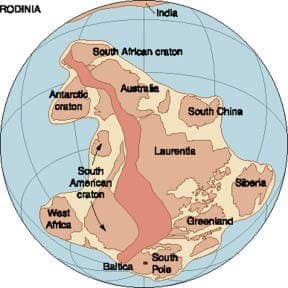
The oldest known supercontinent was called "Rodinia" and formed some 1.1 billion years ago, when there also was only one superocean, which was called the "Panthalassic Ocean" (or "Panthalassa") and eventually became the present-day Pacific Ocean. (c) NASA
Despite an evident contrast, geologists claim that the region of modern day El Paso, Texas was once attached to the now icy continent of Antarctica, in an effort to piece together the giant pieces of a puzzle that formed a pre-Pangaea supercontinent.
“Most people are familiar with Pangaea,” said study co-author Staci Loewy, a geochemist at California State University, Bakersfield. “That was a supercontinent that formed 300 million years ago.”
About 1.1 billion years ago, most of the world’s landmass was contained within a supercontinent called Rodinia, Pangaea’s predecessor. Today’s continents came to be after a plate tectonics process, which continues to this day, separated Pangaea into multiple land masses about 250 million years ago.
If it might seem incredibly difficult to pinpoint where and when supercontinents formed or split, it’s because it is. Scientists have to trace ancient mountain belts or analyze a myriad of data filled with geological patterns to assert a sound geological statement.
In this particular case, the team of researchers, lead by Loewy, collected rocks from a region known as the North American Mid-continental Rift System – a volcanic zone stretching from Canada to the Franklin Mountains near El Paso. Another set of rocks was collected from the mountains in Coats Land in East Antarctica, on the coast of the Weddell Sea. The rock sampling in Antarctica was a bit more difficult, since most of the mountains were covered in ice, except “two tiny tips of mountain peaks,” Loewy said.
After a careful analysis of the samples from both regions, scientists concluded that the sites match in age and in lead isotope ratio, meaning that the volcanic rocks erupted in the same rift zone. Oddly enough, although hugely separated nowadays, scientists concluded in their study that the two landmasses were once connected.
“It’s such a neat thing,” she said, referring to the past ties between the West Texas desert and Antarctica’s glaciers. “It’s a quite spectacular contrast.”
While the study, published in the journal Geology, is extremely interesting, even more fascinating similar geological studies are been made, as scientists painstakingly try to trace down the origins of even older supercontinents.
“There are people who have put forth models of earlier supercontinents. One, called Columbia, [may have] existed from 1.8 to 1.5 billion years [ago],” Loewy said.
“And at 2.4 to 2.6 billion years ago, there seems to have been another major event,” she said. “There appear to have been multiple cycles throughout time.”









